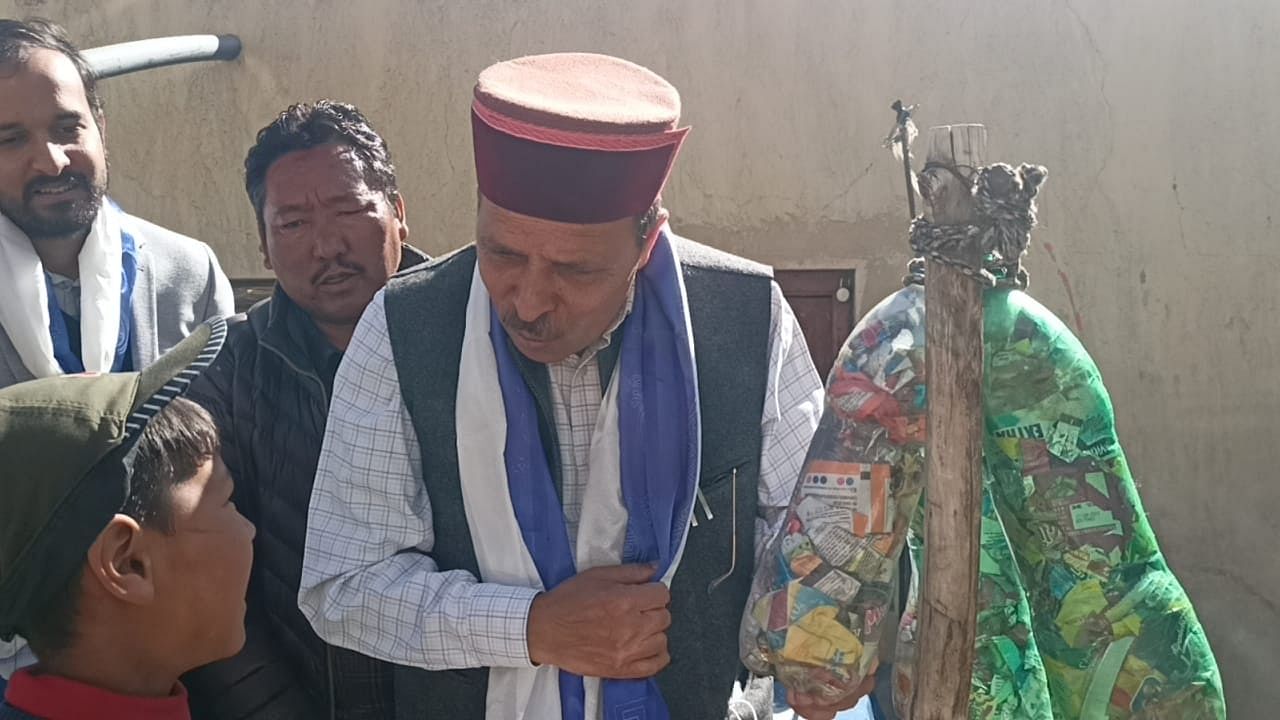
The ideals of environment protection displayed by three minor siblings largely owing to Buddhist thoughts have set an example for others, especially for city dwellers, to replicate the ways to curb plastic litter piling on the higher reaches of the Himalayas. Here the impact of climate change is keenly felt even on agriculture – the mainstay of the local economy.
The siblings — Tenzin of Class IV, Thinley Palmo of Class II and the youngest Cheering Palmo — from a remote village in Spiti Valley of Himachal Pradesh presented five plastic bottles filled with plastic wrappers to visiting Tribal Development Minister Ram Lal Markanda, who asked the local administration to honour them for promoting behavioural change.
"I have asked my children not to dispose the plastic waste in the garbage bins. Now they are packing waste wrappers of chocolates, biscuits and chips in empty pet bottles of one litre or two litres and using a stick to push all the plastic deep into the bottle. Later, the bottles are handed over to the local authorities to use as poly bricks," father Tenzin Lama of Lingti village, one of the highest inhabited places on earth, told IANS over phone.
According to the UN Environment Programme, the initiative to recycle plastic highlights the economic and environmental opportunities when the globe moves from a linear economy, where products, once used, are discarded, to a circular one, where products and materials continue in the system for as long as possible.
According to the UNEP, plastic production has risen exponentially in the last decades and now amounts to some 400 million tons per year – a figure set to double by 2040.
Local authorities say the pet bottles filled with non-recycled plastic will be used as poly bricks for construction of a breast wall, a low stone wall that is constructed on the hillside to support the bank of the earth.
The minimum weight of a poly brick from a two litre bottle stuffed with plastic waste is 500 grams.
Block Development Officer Tashi Dolkar told IANS that the locals, especially school-goers, have been encouraged to dump non-recycle waste so that it can be used as sustainable low-cost construction material for laying tiles and the retaining walls.
She said students in Kibber village have constructed a bench made from poly bricks.
Located at 14,010 feet, Kibber village in Lahaul-Spiti district some 20 km from subdivision Kaza, covered by snow during most of the year, is known for a Buddhist monastery and a wildlife sanctuary, the habitat of the snow leopard.
Agriculture, which is facing the brunt of climate change, is the prime occupation of the picturesque but thinly populated Spiti Valley that is flush with a single crop of vegetables, mainly the high-valued broccoli and lettuce, and is irrigated exclusively by snow and glacial melts in summer.
In the entire valley, houses are made from locally available stones with no use of bricks and building material.
In recent years, livestock in the high mountains have started dying a slow and painful death as locals complain plastic food wrappers have been found in their stomachs, resulting in impaction that causes failure of digestion.
The Spiti Valley, a cold desert dotted by tiny hamlets spread over the Himalayan peaks, adjoining Tibet, takes you to a land of Buddhism and virgin nature.
Members of the hospitality industry say the Spiti Valley these days saw a sudden influx of tourists with the opening of high mountain passes. The Buddhist-dominated valley attracts globetrotters not only for nature-based activities but also to ancient monasteries like Tabo and Dhankar.
The ugly fact is that despite the authorities installing waste disposal and drop off points visitors carelessly dump non-biodegradable waste along the banks of the glacial-fed rivers.
One can be horrified to see the amount of garbage like polythene and paper bags, empty beer and liquor bottles, food sachets and clothes dumped carelessly in the mountains.
As part of Himachal Pradesh's initiative launched on October 2, 2019, it is to buyback non-recyclable plastic waste. Every year about 60 tonnes of plastic waste is collected.
Under the buyback policy, the government is procuring plastic waste at a minimum support price of Rs 75 per kg. Under the scheme, 227 tons of plastic has been procured till date.
At least 10 per cent of the plastic waste is being used in surfacing roads by the Public Works Department, while the rest is being procured by four cement facilities for kilns, replacing a portion of conventional fossil fuels, like coal.
Officials told IANS that if the plastic waste could be mixed up to 15 per cent, this would lead to a saving of the equivalent quantity of asphalt, reducing the overall road construction cost.
Himachal Pradesh imposed on October 2, 2009, a ban on the production, storage, use, sale and distribution of all types of polythene bags made of non-biodegradable material.
The government later included all plastic materials like disposable plates, cups and glasses in the ambit of the ban.
Before the partial implementation of the ban in 2004, polythene pollution was a major problem in the state. During the monsoon, the rainwater brought along heaps of polythene bags and other non-biodegradable material that choked most drains.
In a landmark resolution in March, heads of state, environment ministers and other representatives from 175 nations, endorsed a resolution at the UN Environment Assembly in Nairobi to end plastic pollution, and forge an international legally binding agreement, by the end of 2024.
The resolution addresses the full lifecycle of plastic, including its production, design and disposal.